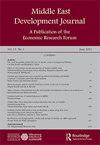Accessibility, transportation cost, and regional growth: a case study for Egypt
IF 0.9
Q4 DEVELOPMENT STUDIES
引用次数: 12
Abstract
This paper focuses on a proposed development corridor in Egypt, a main component of which is a desert-based expansion of the current highway network. The main beneficial features of this proposed transport investment are travel time reductions and improved accessibility. We use a spatial computable general equilibrium (SCGE) model to estimate the economic impacts of changes in transportation costs from this new roadway. To effect this, we integrate the model with a stylized geo-coded transportation network to estimate the spatial distribution of changes in transportation costs. Ignoring the cost of the infrastructure itself, we employ a series of simulations to estimate the likely structural economic impacts that such a large investment in transportation could enable through a series of simulations. Results show the Corridor causes the economic tide to rise for the economies of all Egyptian governorates. Gains in efficiency are particularly strong for those regions that are presently most isolated, namely those located to the southern and western extremes of the country. This suggests that the project will lessen regional disparities across Egypt’s governorates. We therefore show that integrated SCGE models can be useful in estimating the potential economic benefits of transportation projects in developing nations like Egypt. Moreover, it is clear that interregional economic models can be vital in examining the varied spatial distribution of the benefits that derive from geographically targeted government spending.可达性、运输成本和区域增长:以埃及为例
本文重点介绍了埃及拟建的发展走廊,该走廊的主要组成部分是对现有公路网的沙漠扩建。这项拟议交通投资的主要有益特点是减少了出行时间,改善了可达性。我们使用空间可计算一般均衡(SCGE)模型来估计这条新道路运输成本变化的经济影响。为了实现这一点,我们将该模型与风格化的地理编码交通网络相结合,以估计交通成本变化的空间分布。忽略了基础设施本身的成本,我们采用了一系列模拟来估计通过一系列模拟,如此大规模的交通投资可能带来的结构性经济影响。结果显示,走廊使埃及所有省份的经济都在上涨。对于目前最孤立的地区,即位于该国南部和西部极端的地区,效率的提高尤其强劲。这表明该项目将缩小埃及各省之间的地区差异。因此,我们表明,综合SCGE模型可以用于估计埃及等发展中国家交通项目的潜在经济效益。此外,很明显,区域间经济模型对于研究以地理为目标的政府支出所产生的利益的不同空间分布至关重要。
本文章由计算机程序翻译,如有差异,请以英文原文为准。
求助全文
约1分钟内获得全文
求助全文

 求助内容:
求助内容: 应助结果提醒方式:
应助结果提醒方式:


